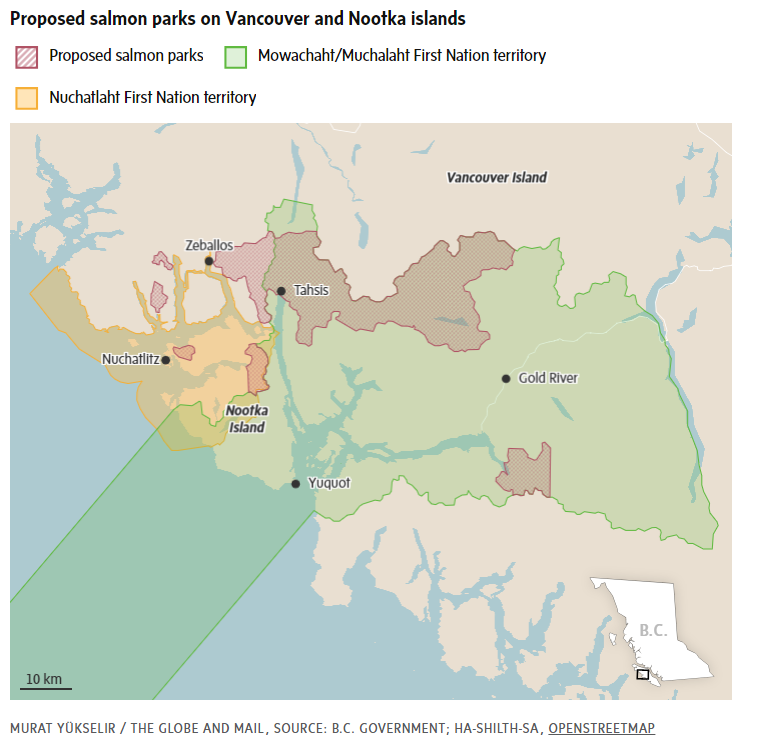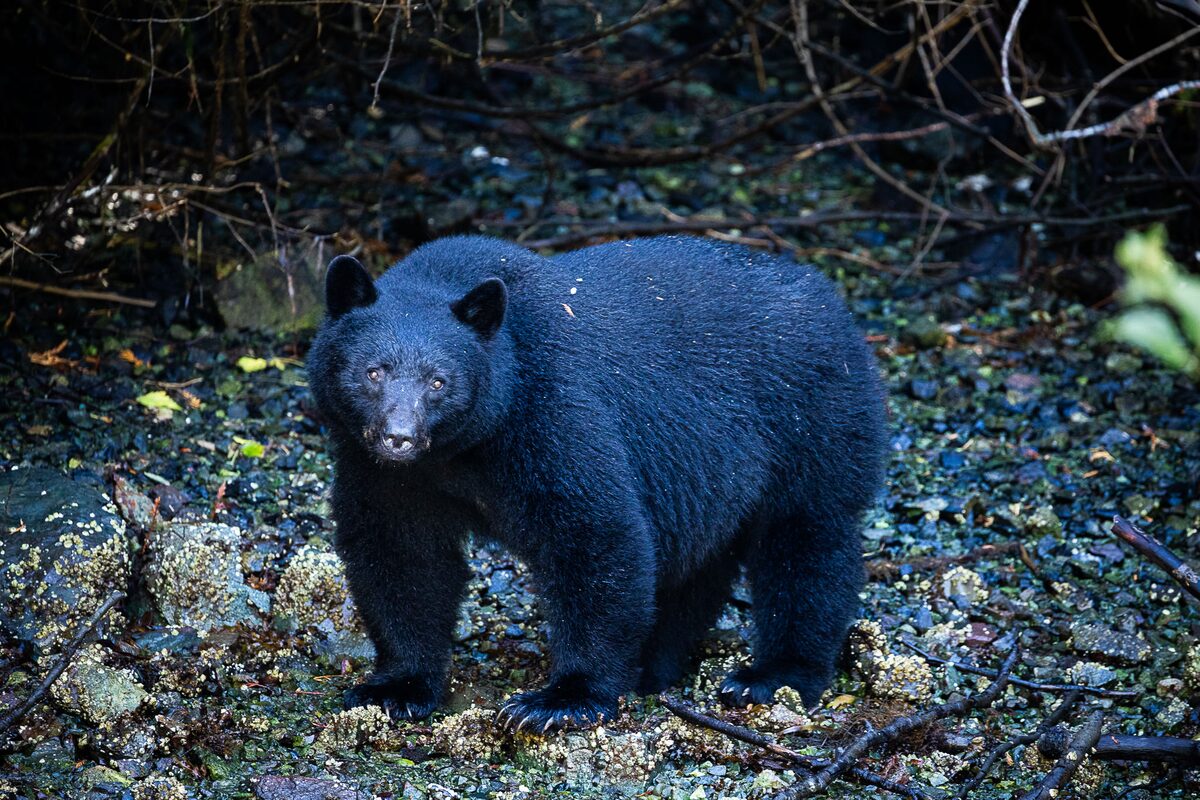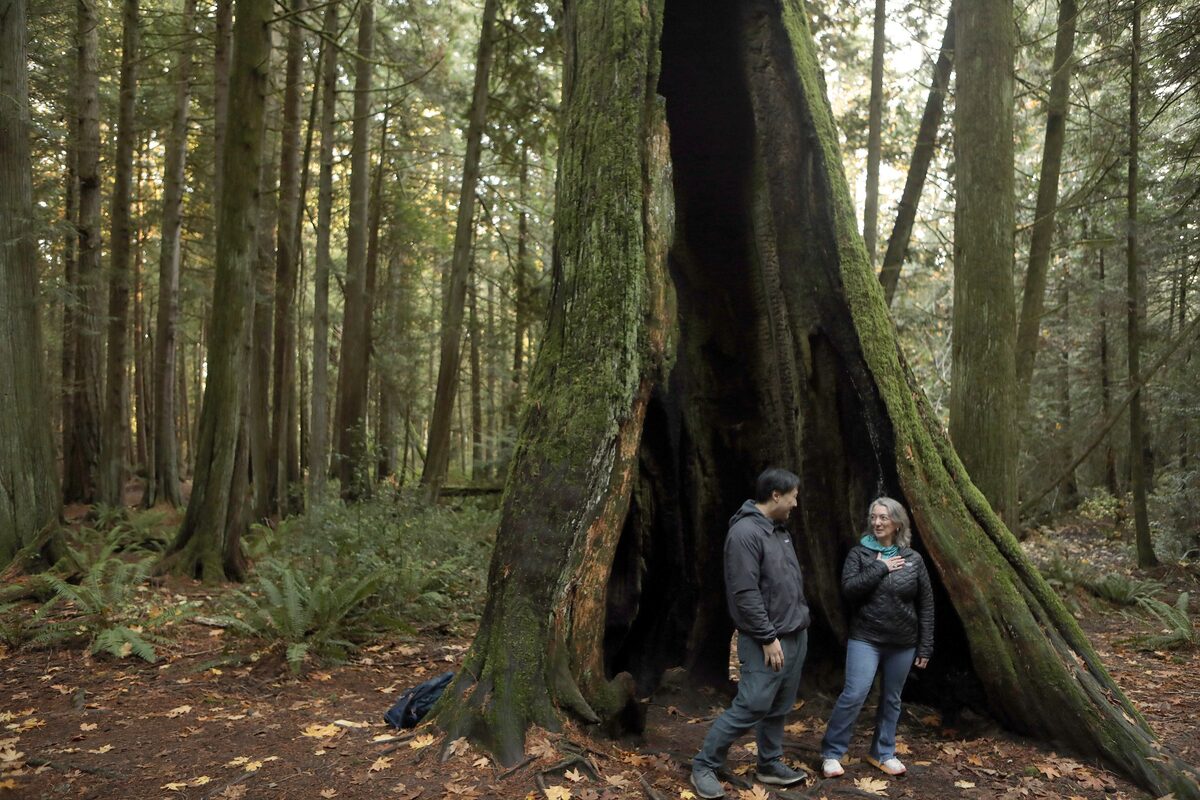
Environmentalist Ken Wu takes federal MP Julie Dabrusin on a tour of old-growth forest at Francis/King regional park on Vancouver Island. Ms. Dabrusin, parliamentary secretary to the Environment Minister, helped broker a tripartite deal to protect forests around Nootka Sound from logging. CHAD HIPOLITO/THE GLOBE AND MAIL
New plan from the Mowachaht/Muchalaht First Nation, aided by the B.C. and federal governments, signals a shift in Indigenous-led conservation across the province.
Backed by a $15.2-million commitment from the federal government, a First Nations community on the west coast of Vancouver Island intends to buy out forestry tenures to stop old-growth logging in selected watersheds around Nootka Sound.
The Mowachaht/Muchalaht First Nation has declared a string of “salmon parks” in its traditional territories that includes more than 66,000 hectares of watersheds.
The parks are designed to protect critical salmon habitat by maintaining and restoring the land where it intersects with marine ecosystems. Logging can damage the rivers where salmon spawn, and deforestation has been tied to warmer rivers that reduce survival rates for young fish.
The salmon parks of Nootka Sound offer an example of a shift that is coming across the province as a result of the new $1-billion Nature Agreement signed on Nov. 3 between Canada, B.C. and the First Nations Leadership Council. Significantly more land will be designated for conservation, which in turn will change how and where the province exploits its natural resources.
To meet commitments by the federal and provincial governments, B.C. will need to set aside more than 10 million hectares of new biologically important areas for protection from development over the next six years. Much of that will be achieved through Indigenous-led conservation projects that are now on a fast track for approval. This includes the Mowachaht/Muchalaht First Nation plan, which will require additional funding to complete.
British Columbia has the greatest diversity of species, ecosystems and habitats of any jurisdiction in Canada, and both the federal and provincial governments have promised to protect 30 per cent of the country’s land and water by 2030.
The provincial government says there are currently 18.5 million hectares of protected and conserved areas, making up 19.6 per cent of B.C.’s total land.
A number of First Nations in B.C. have declared Indigenous Protected and Conserved Areas that will be among the first in the queue for consideration by the new tripartite committee, which will decide where the nature agreement funding will go. Federal Environment and Climate Change Minister Steven Guilbeault promised financing for the Mowachaht/Muchalaht salmon parks in late October, providing tacit approval of the First Nation’s IPCAs.
Five species of Pacific salmon run through the traditional territories of the Mowachaht/Muchalaht First Nation, but stocks are in decline. Eric Angel, the project manager for the salmon parks, said the selected areas include some of the last remaining old-growth forest ecosystems in the region.
“What we are bringing to this is a much more creative and nuanced view of what a sustainable economy looks like in rural communities. What we’ve been doing up till now has been liquidating a one-time resource, old-growth forests. What we need to do is find ways to harvest forest products,” he said, “while we also build economies around tourism and conservation and stewardship.”
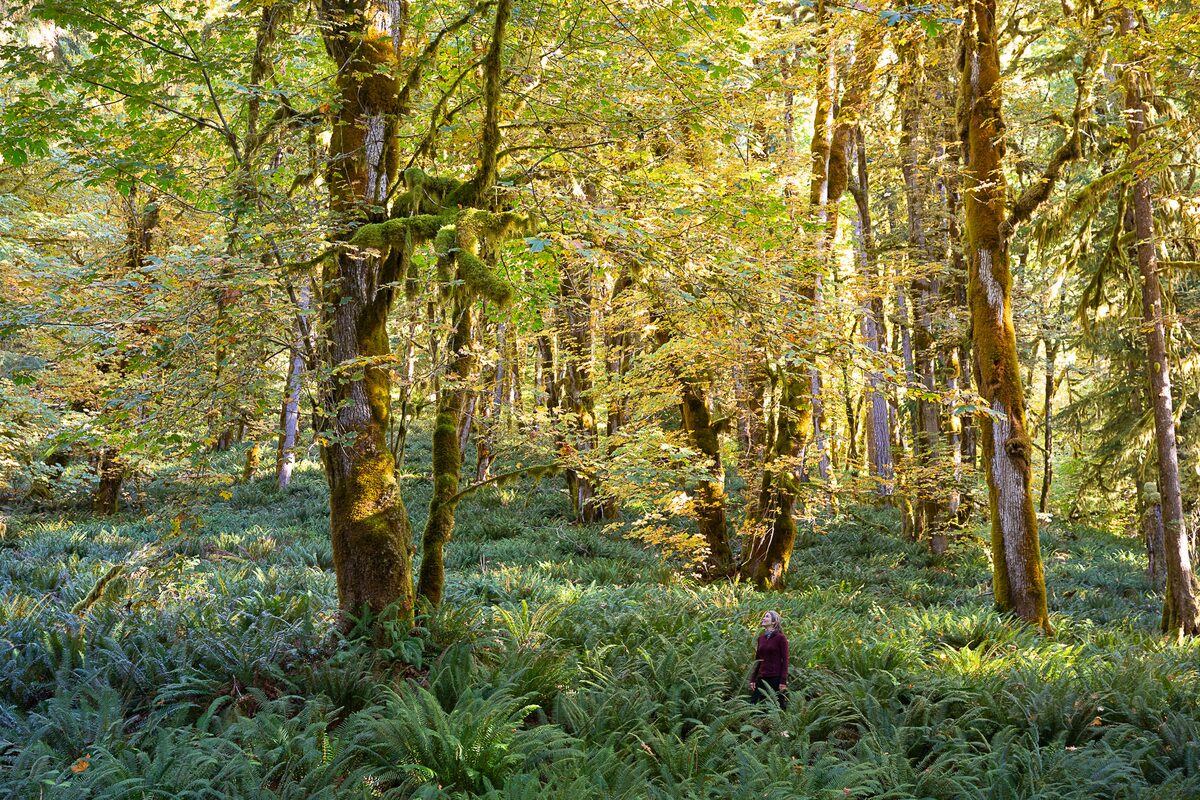
Celina Starnes from Endangered Ecosystems Alliance looks up at the big-leaf maple grove of the Burman River valley, which lies within the Mowachaht/Muchalaht salmon-park system. TJ WATT
The village of Gold River, located in the heart of Mowachaht/Muchalaht territory, was built as a forestry community, but the last mill closed in 1999. The salmon-parks strategy will balance economic development with ecology, Mr. Angel said, and some of the funds will help develop those plans. By clearly identifying which lands must be protected, industry will better understand where resource extraction will be allowed, and what kind of activities would be welcomed.
Based on studies by biologists, the First Nation has determined that 90 per cent of salmon productivity in the region can be protected by setting aside 20 per cent of the watersheds – especially those where glacier-fed rivers offer the greatest climate resiliency.
The provincial government, which awards forestry tenures, has not yet weighed in on the salmon parks. However, Nathan Cullen, B.C.’s Minister for Land, Water and Resource Stewardship, said that his government needs to endorse IPCAs to reach its conservation targets. “Getting there would be absolutely impossible without willing First Nations partners.”
He believes IPCAs also hold the key to ensuring that this transition can be done without cratering the province’s resource-based economy. Conservation decisions will bring certainty to land that has long been mired in conflict because of unresolved Indigenous claims. First Nations communities have told him, he said, that they will be more open to extraction industries after the areas they have identified for conservation are protected. “The whole point of land-use planning is to lessen the conflict, lessen the legal challenges and increase certainty for investors while protecting more of the province.”
But that process can be expensive. The largest cost associated with the Mowachaht/Muchalaht IPCAs will be the purchase of logging tenures from industry. To implement the plan, the First Nation expects it will need to raise as much as $50-million. “It will cost money because the companies will not just say, ‘Okay, yeah, take our tenure and make a reserve.’ So everyone will need to be compensated,” said Azar Kamran, chief executive officer and administrator for the First Nation.
Western Forest Products, one of those tenure holders in Nootka Sound, is aware of the salmon-parks plan, said Babita Khunkhun, a spokesperson for the company. “While we have not had specific discussions with the Nation since the recent announcement, we work to understand and incorporate the interests of Indigenous communities through open communication and that ongoing commitment will serve to guide us going forward.”
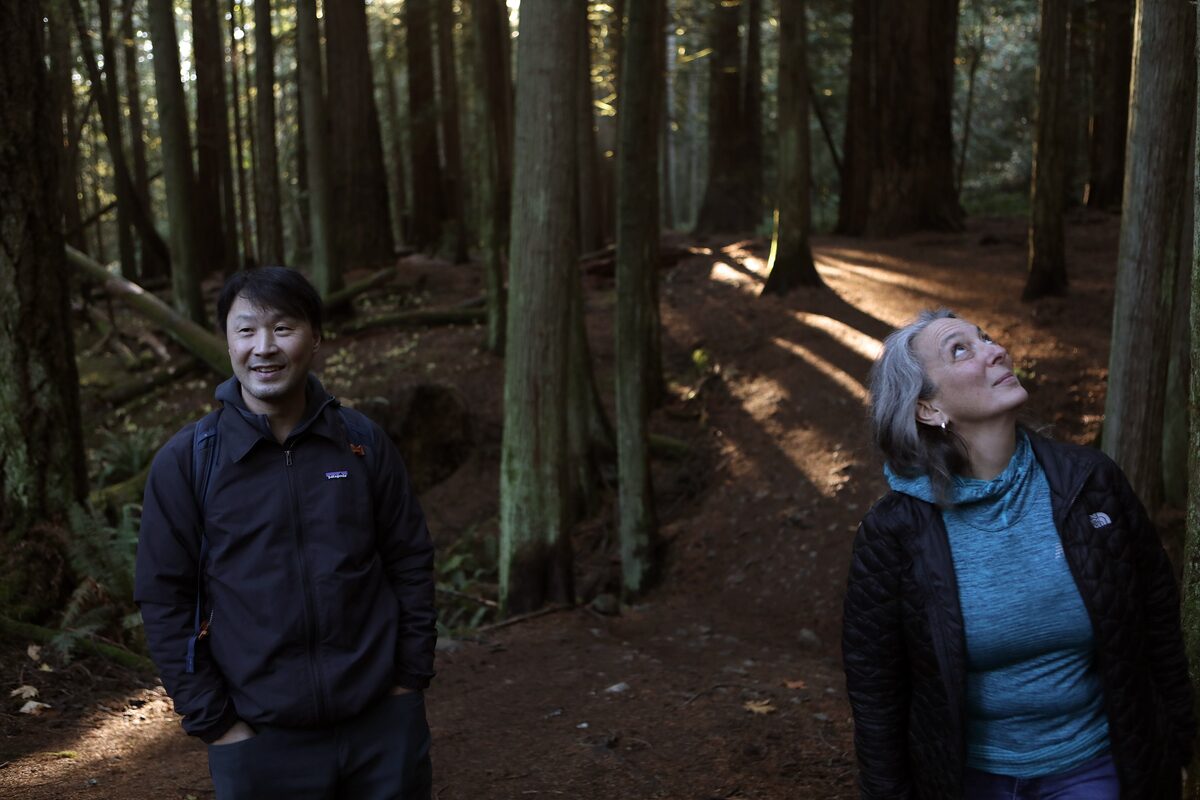
‘We’ve been clear for a number of years now that protecting our old-growth forests is one of our priorities,’ Ms. Dabrusin says. CHAD HIPOLITO/THE GLOBE AND MAIL
Ottawa has agreed to invest up to $500-million across all projects over the life of the tripartite agreement, with matching funding to come from the province. Philanthropic organizations are also expected to contribute. It took two years to negotiate and now it could take another year to set up the committee.
Julie Dabrusin, parliamentary secretary to Mr. Guilbeault, was one of the brokers. On a recent visit to B.C., she visited an old-growth forest where 500-year-old Douglas firs rival the height of the concrete towers of her home riding of Toronto-Danforth.
The trees in Francis/King Regional Park, near Victoria, are already protected, but she said seeing them was a good reminder of the purpose of her assignment, which was to help secure an agreement that would allow the federal Liberal government to achieve its “30 by 30″ commitment.
She acknowledged concerns that B.C.’s old-growth forests are being logged while the process unfolds. “I think that there is always an urgency to get beyond talking. We’ve been clear for a number of years now that protecting our old-growth forests is one of our priorities.”
Leading Ms. Dabrusin’s old-growth tour was Ken Wu, who heads the Endangered Ecosystems Alliance and has spent decades campaigning for protected areas. Meeting Canada’s conservation targets will be “a monumental undertaking,” he said, but with $1-billion or more, and a framework that puts First Nations in the driver’s seat, the past month has given environmentalists something to celebrate.
“In the coming months and years we’re going to see – I’m certain of it – the biggest protected areas expansion in Canadian history within a province.”
JUSTINE HUNTER
The Globe and Mail, November 29, 2023

